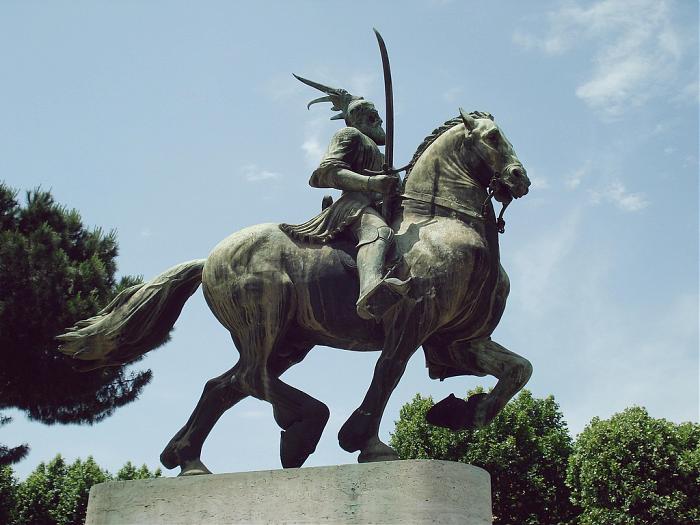Oh, you mean the Irish-American soldier ref;
who knows, def. not an option that is the primary, but an option nonetheless;
I dont know, why you consider the
Umbrians as the the last Indo-European wave, given what the classical authors wrote:
Pliny - Natural History (79 AD)
The race of the Umbri is considered the oldest in Italy. —(C. Plin. lib. ii. Nat. Hist. c. 14.)
Dionysius - The Roman Antiquities (29 BC)
The Umbri inhabited a great many other parts of Italy, and were an exceeding great, and ancient people.
Cambrian Institute - The Cambrian Journal (1862)
from
Caius Sempronius (De Divis. Ital.);
"The portion of the Apennines from the sources of the Tiber to the Nar, the Umbri inhabit, the oldest stock of the Old Gael, (Veteres Galli), as Augustus writes."
[Apenninum colunt Ligures, portionem vero Apennini inhabitant Umbri, prima veterum Gallorum proies, ut Augustus scribit]
Also, the
Herodotus map only mentions the
Ombri - [next to
Thyrreni, Eneti, Ligyes]
The
Ligurians are a key people in the Po valley, (
also Rhone Valley and Maritime Alps);
It seems [based on Anthropology] that the
Ligurians were already present in the Neolithic and were [
Brachycephalic] Pre-Indo-Europeans akin to Lapps.
Smithsonian Institution - Report of the Board of Regents: Vol.45 (1891)
In another Neolithic cave, called the Caverna della Matta [north Italy], an Iberian skull was found with an index of 68, and a Ligurian skull with an index of 84. No anthropologist would admit that these skulls could have belonged to men of the same race.
Roberto Bosi - The Lapps (1977)
Then [Rudolf Karl] Virchow. examining a number of Lappish skulls at Helsinki, Lund and Copenhagen, in conjunction with ancient Ligurian skulls, discovered many mutual features suggesting an identical strain.
The
Umbrians must have mixed with the
Ligurians,
as
Plutarch informs us that the
Ligurians referred to themselves as
AMBROnes in connections to their Origins;
Anthropological evidence:
Anthropological Society of London - Anthropological review: Vol.V (1867)
"when I look upon the delineations of the crania, the photographs and the figures given by M. Nicolucci himself, it appears to me that the difference between Ligurians and Umbrians, is about equal to the differences between Allemands and Germans.
The same scenario happened in the
Swiss Lake Dwellings -
Indo-Europeans mixed with a Brachycephalic (pos. Ligures) Pre-Indo-European people.
George Bradshaw - Bradshaw's illustrated hand-book to Switzerland and the Tyrol (1899)
Swiss Lake-dwellings - In his careful investigations of pile dwellings, Dr. Studer met with two extreme types of skulls, the brachycephalic and the dolikoccphalic; the former, at Schaffis and Lüschery (Lake of Bienne), belonging to the pure Stone period, and the latter, at Vinolz and Sutz, to the Bronze period. The facts point to an invasion by the Bronze men, involving a complete transformation of the group of domestic animals; the horse appears for the first time, and new races of sheep and dogs replace the older forms of the Stone period. The occurrence of mesocephalic, and even considerably shortened skulls, in the Bronze period, shows that there was no extinction of the brachycephalic race, but that the two races mixed.
I will post more about the Ligures in
History & Civilisations > Who were the Sabines?
Personally, i think
the last Indo-Europeans arriving in Italy were
the
Illyrians in the South-East [
Messapii / Iapyges]
I disagree about your Y-DNA Hg E analysis.
Area I =
Liguria + Lombardy + Piedmont and is only high on E-V13 [9.3%]
1.8% other E-M78
sub-clades and 0.6% E-M123; thats all;
- so i wouldnt consider
Liguria isolated to be any stronger;
I agree with your view about the present-Ligurians in contrast to the ancient-Ligurians;
but there is an historic region
Lunigiana that was/is still very remote and has a grand ancient-Ligurian (
Archaeological) Legacy.
One sample-set of Tuscany (in Boattini et al 2013) is from that region. Tuscany being 37% R1b-U152



